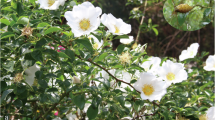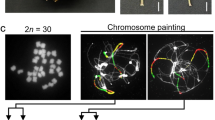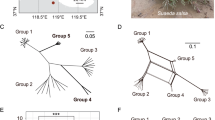Abstract
The chromosomes of Festuca drymeja are larger than those of Lolium multiflorum and the two complements can be distinguished in the F1 hybrid and allotetraploid. Chromosome associations at metaphase 1 in the amphidiploid was typical of an allopolyploid because all the bivalents were symmetrical, which indicates complete preferential homologous chromosome pairing. Chromosome behaviour within the two genomes of the amphidiploid differed from that in the corresponding diploid species. The mean chiasmata per bivalent of the F. drymeja complement was much higher in the allotetraploid than in the diploid species and there was a corresponding reduction in the L. multiflorum complement compared with the diploid. Total chiasma frequency of the amphidiploid was determined by the additive effect of the two genomes but there is evidence that the distribution of chiasmata was related to the specific genomes.
Similar content being viewed by others
Article PDF
References
Gamborg, O L, Miller, R A, and Ojima, K. 1968. Nutrient requirements of suspension cultures of soyabean root cells. Exp Cell Res, 50, 151–158.
Jones, H A, and Clarke, A E. 1942. A natural amphidiploid from an onion species hybrid. Allium cepa × A. fistulosum. J Hered, 33, 25–32.
Morgan, W G. 1990. Cytogenetic studies in triploid and amphidiploids involving Lolium and diploid Festuca species. Genome, 33, 472–477.
Morgan, W G, and Thomas, H. 1983. Hybrids between L. multiflorum and F. drymeja. In: Annual Report of the Welsh Plant Breeding Station for 1983, p. 116.
Morgan, W G, Thomas, H, and Kirby, M. 1979. A study of chromosome association in hybrids between diploid species of Festuca. Chroomosoma (Berl), 75, 117–127.
Parker, J S. 1975. Chromosome-specific control of chiasma formation. Chromosoma, 49, 391–406.
Seal, A, and Rees, H. 1982. The distribution of quantitative DNA changes associated with the evolution of Festuceae. Heredity, 49, 179–190.
Snow, R. 1963. Alcoholic hydrochloric acid-carmine as a stain for chromosomes in squash preparations. Stain Technol, 38, 9–13.
Tease, C, and Jones, G H. 1976. Chromosome-specific control of chiasma formation in Crepis capillaris. Chromosoma, 57, 33–49.
Thomas, H M, and Morgan, W G. 1990. Analysis of synaptonemal complexes and chromosome pairing at metaphase 1 in the diploid inter-generic hybrid Lolium multiflorum × Festuca drymeja. Genome, 33, 465–471.
White, J, and Rees, H. 1985. The chromosome cytology of a somatic hybrid petunia. Heredity, 55, 53–59.
Author information
Authors and Affiliations
Rights and permissions
About this article
Cite this article
Morgan, W., Thomas, H. A study of chromosome association and chiasma formation in the amphidiploid between Lolium multiflorum and Festuca drymeja. Heredity 67, 241–245 (1991). https://doi.org/10.1038/hdy.1991.85
Received:
Issue date:
DOI: https://doi.org/10.1038/hdy.1991.85



